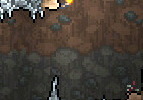Layers
A world in Terraria is divided into five layers, each appearing at different depths, or elevations. Each layer has its own characteristics, and most layers contain multiple biomes.
Depth can be determined via a Depth Meter or any of its derivative accessories:
- On the
 Desktop version,
Desktop version,  Console version, and
Console version, and  Mobile version, depth is measured in feet, with one tile equaling two feet.
Mobile version, depth is measured in feet, with one tile equaling two feet. - On the
 Old-gen console version, depth is measured in meters, with two tiles equaling one meter.
Old-gen console version, depth is measured in meters, with two tiles equaling one meter. - On the Nintendo
 version, depth cannot be measured, as informational tools are not available.
version, depth cannot be measured, as informational tools are not available.
The Depth Meter numbers feet or meters above Level Surface, then feet or meters below Level Surface. Each reading includes a layer name: Space, Surface, Level Surface, Underground, Caverns, and Underworld. The range of numbers depends on platform, world size, and the randomized world generation of each world.
Space
Space is the topmost layer. It generally contains no natural structures, although Floating Islands and Living Trees may occasionally extend into it. The sun, moon, and stars are visible here against a backdrop that is always black, regardless of the time of day. Gravity is reduced in Space, making characters jump higher and fall more slowly. Harpies spawn here, and in Hardmode, Wyverns and Arch Wyverns(Old-gen console and 3DS versions).
Surface
The surface includes the Forests, Deserts, Corruption, Crimson, Jungle, Snow, Hallow, and Ocean biomes. Meteorite biomes will usually be found here when they generate. The entrance to the Dungeon is also found here. This layer also usually contains the world's Floating Islands, although these are generally located some distance above the main land mass. A surface Glowing Mushroom biome can be seeded here by players, but will never occur naturally.
Only in the surface layer will regular, Corruption/Crimson and Hallow grass naturally grow and spread (although grass can be planted with seeds or the Staff of Regrowth in other layers, it will not spread). Trees and Corruption/Crimson thorny bushes will only grow in the surface layer. Terrain blocks cover a large amount of the lower surface layer, with Dirt Walls behind them.
Areas below the actual terrain surface (areas the player must dig in order to access) are still considered "surface" if they are above the Depth Meter's "Level Surface" (0 feet).
Underground
The underground layer contains the same biomes as the surface layer. It ranges from 0 feet to the top of the Cavern layer, and has a unique backdrop that depicts dirt with stones set in it.
Cavern
The Cavern layer is the largest layer. Its backdrop is the same as that of the Underground, except the dirt is of a darker hue, resembling stone. It contains the Ice biome, Underground Jungle, and Underground Desert(Desktop, Console and Mobile versions) biomes, which are each located beneath their surface versions, as well as Underground Glowing Mushroom biomes. It additionally contains generic cavern features that fill the area between those distinct biomes. In Hardmode, the additional Underground Corruption/Crimson and Underground Hallow will form. A large section of the Dungeon also extends through this layer.
The Cavern layer may be subdivided into the upper and lower Cavern layers. The main differences are that the Ice biome ends at the bottom of the upper Cavern layer, and lava pools are usually only found in the lower Cavern layer.
Underworld
This layer consists of the bottom 300-odd feet of the map, below the Cavern layer. Its backdrop is open space with magma pools and pillars. The Underworld is its own biome and does not contain other biomes within it. Lava is abundant here. Any water that flows into this layer disappears ("evaporates") quickly.
Trivia
- The
 World Banner depicts the world's layers.
World Banner depicts the world's layers.


